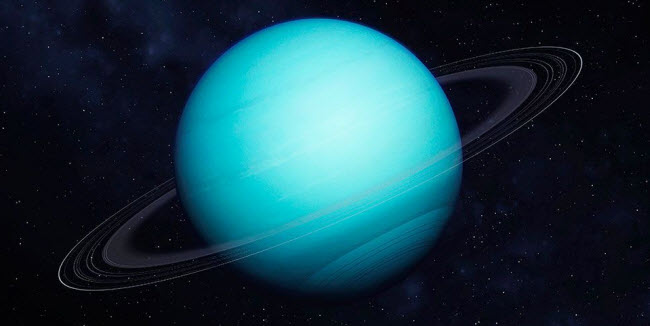Uranus is the seventh planet from the Sun and the third-largest in the solar system, following Jupiter and Saturn. With a size nearly four times that of Earth, Uranus was the first planet to be discovered using a telescope. Initially mistaken for either a comet or a star, its status as a planet was confirmed after careful observation. Although it shares some characteristics with Jupiter and Saturn, Uranus is distinct in being classified as an ice giant, not a gas giant like the other two. Despite its vast size, Uranus lacks a solid surface and is mainly composed of hydrogen and helium, along with icy components such as water, ammonia, and methane.
One of Uranus’ most remarkable features is its extremely cold atmosphere, making it the planet with the coldest temperatures in the solar system. Its core is primarily made of rock and ice. Like other giant planets, Uranus has a system of rings and a strong magnetic field. What sets Uranus apart is its unusual axial tilt, which is almost perpendicular to the plane of its orbit around the Sun. As a result, its poles are located where most planets have their equators. This unique tilt makes Uranus an intriguing object of study for astronomers today, who consider it a prime target for future exploration.
Mythological Origins and Discovery
Uranus is named after the ancient Greek god of the sky, Uranus, who, according to mythology, was the grandfather of Ares (Mars), the father of Cronus (Saturn), and the great-grandfather of Zeus (Jupiter). The planet was discovered in 1781 by astronomer Sir William Herschel, making it the first planet found in the modern scientific era. Herschel initially wanted to name it after King George III, but the name Uranus was ultimately chosen. Uranus has 27 known moons, most of which are thought to be composed of a mixture of ice and rock. Interestingly, unlike other moons in the solar system named after figures from Greek and Roman mythology, Uranus’ moons are named after characters from the works of William Shakespeare and Alexander Pope. Uranus also has two distinct sets of rings: an inner set of nine dark, narrow rings, and an outer set with two more colorful rings—one red and one blue.
Size and Distance from the Sun
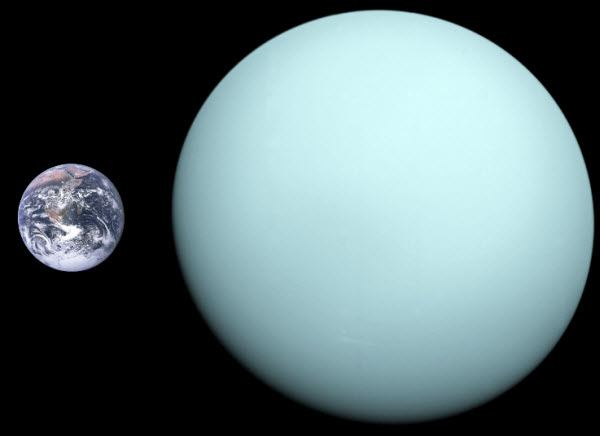
Uranus has a radius of 25,362 kilometers, making it four times the size of Earth. If Earth were the size of a coin, Uranus would be the size of a baseball. It is located an average distance of 2.9 billion kilometers from the Sun, equivalent to 19.8 astronomical units (AU), with one AU being the distance from the Earth to the Sun. At this distance, sunlight takes about 2 hours and 40 minutes to reach Uranus.
Orbit and Rotation
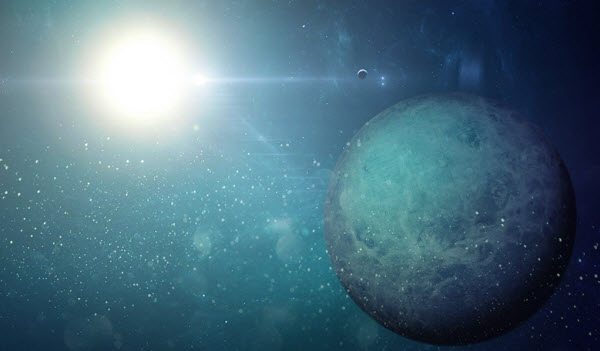
A day on Uranus lasts approximately 17 hours, the time it takes the planet to rotate once on its axis. Uranus completes an orbit around the Sun in about 84 Earth years, or 30,687 Earth days. One of the most unusual characteristics of Uranus is its extreme axial tilt of 97.77 degrees, likely caused by a collision with an Earth-sized object long ago. This tilt results in extreme seasons, with the Sun shining directly over each pole during different parts of Uranus’ long year, leading to 21 years of continuous daylight at one pole and 21 years of darkness at the other.
Additionally, Uranus and Venus are the only planets in the solar system that rotate in the opposite direction to most other planets.
Formation of Uranus
Uranus, like the other planets in the solar system, formed about 4.5 billion years ago when gravity pulled gas and dust together. It is believed to have formed closer to the Sun before migrating to its current position in the outer solar system about 4 billion years ago. Uranus is classified as an ice giant, along with its neighboring planet Neptune.
Structure of Uranus
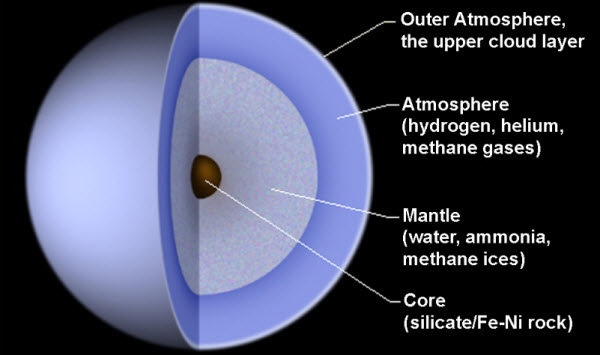
Uranus and Neptune are referred to as “ice giants” because most of their mass consists of icy materials, such as water, methane, and ammonia. These icy substances form a dense, hot fluid that accounts for more than 80% of Uranus’ total mass, surrounding a small rocky core. Near the core, temperatures can reach up to 4982 degrees Celsius. Uranus is the second least dense planet after Saturn, and its blue-green color comes from methane in its atmosphere, which absorbs red light and reflects blue and green.
As an ice giant, Uranus lacks a true solid surface. Any spacecraft attempting to land would find no surface to touch down on and would be destroyed by the extreme pressures and temperatures within its atmosphere.
Atmosphere and Weather
The atmosphere of Uranus is composed mainly of hydrogen and helium, with a small amount of methane. The methane gives the planet its distinctive blue color. Uranus is known for having the coldest atmosphere in the solar system, with temperatures plunging to as low as -224.2 degrees Celsius. Winds on Uranus can reach speeds of up to 900 kilometers per hour, contributing to its extreme weather patterns.
Magnetic Field
Uranus has an unusual and irregular magnetic field. Unlike most planets, whose magnetic fields align closely with their rotation, Uranus’ magnetic field is tilted by nearly 60 degrees from its axis of rotation. As a result, the planet’s magnetic tail stretches millions of kilometers into space, forming an asymmetrical shape. Additionally, its auroras do not occur at the poles, as is the case on Earth, Jupiter, and Saturn.
Potential for Life
The conditions on Uranus are not conducive to life as we know it. The planet’s extreme temperatures, pressures, and atmospheric composition make it highly unlikely that any form of life could survive there.
Exploration of Uranus
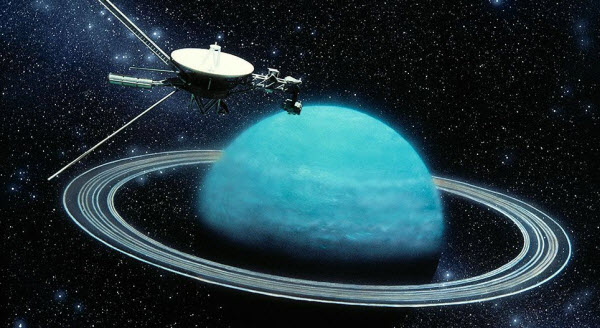
To date, only one spacecraft has visited Uranus: NASA’s Voyager 2, which flew past the planet in 1986 after a nine-year journey covering more than 3 billion kilometers. Voyager 2 provided valuable data about Uranus’ atmosphere, rings, and moons during its brief six-hour flyby. Since then, observations of Uranus have relied on telescopes like the Hubble Space Telescope and advanced ground-based observatories.
